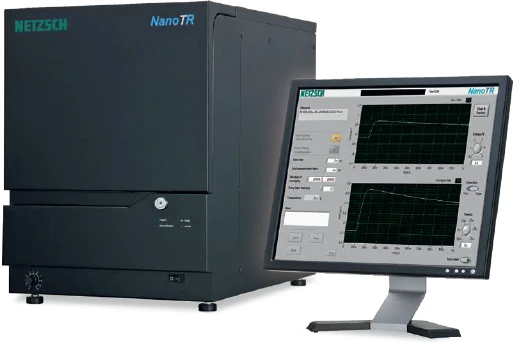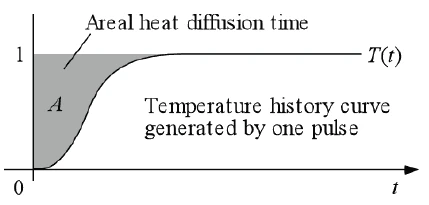Introduction
The Japanese National Institute of Advanced Industrial Science and Technology (AIST) has developed a measurement technique called "pulsed light heating ThermoreflectanceThermoreflectance is a method for determining the thermal diffusivity and thermal conductivity of thin films with thicknesses in the nanometer range.thermoreflectance method", which is a faster version of the laser flash method, and has thus succeeded in measuring the thermophysical properties of thin films ahead of other companies in the world.
The pulsed light heating ThermoreflectanceThermoreflectance is a method for determining the thermal diffusivity and thermal conductivity of thin films with thicknesses in the nanometer range.thermoreflectance method, one of the Time DomainA time domain analysis is based on changes in physical signals related to time. A time-domain graph shows how a signal changes over time. In the case of thermoreflectance or the laser flash method, the detector signal (voltage change) is recorded – at a minimum – over the time range between the energy input and the signal maximum (e.g., RF mode) or as a function of the expected heat diffusion time (e.g., FF mode).Time Domain ThermoreflectanceThermoreflectance is a method for determining the thermal diffusivity and thermal conductivity of thin films with thicknesses in the nanometer range.Thermoreflectance (TDTR) methods, is a technique in which a thin film formed on a substrate is instantaneously heated by irradiating it with a picosecond or nanosecond pulsed laser, and the high-speed temperature change due to thermal diffusion after heating is measured by the reflected intensity change of laser light for temperature measurement.
Rear Heating/Front Heating Versus Front Heating/FrontDetection
There are two types of this method: An arrangement in which the sample is heated from the transparent substrate side (in the case of infrared light, Si is also a transparent substrate) and the temperature rise of the sample surface is measured (Rear heating / Front detection (RF) mode, fig. 1b), and an arrangement in which the sample surface is heated and the temperature rise of the same location on the sample surface is measured (Front heating / Front detection (FF) mode, fig. 1a).
In principle, the RF mode is identical to the laser flash method, which is the standard Thermal DiffusivityThermal diffusivity (a with the unit mm2/s) is a material-specific property for characterizing unsteady heat conduction. This value describes how quickly a material reacts to a change in temperature.thermal diffusivity measurement method for bulk materials, and features excellent quantitative reliability. Contrary to the RF mode, the FF mode can measure thin films on opaque substrates and is important as a practical measurement technique.
Since the discovery of conductive polymers (doped polyacetylene) by the Nobel prize winners H. Shirakawa, A. J. Heeger and A.G. MacDiarmid [1], they have been extensively developed and used in various products such as antistatic films, solid electrolytic capacitors and organic EL*. More recently, the focus has been more on the development of organic transistors and organic thermoelectronic materials, and it is expected that poly (3,4- ethylenedioxythiophene) polystyrene sulfonate (PEDOT: PSS) will turn out to be a promising material for this application.
The efficiency of thermoelectric materials is represented by the dimensionless figure of merit, ZT. The dimensionless figure of merit, ZT, is expressed by ZT=S2T/(ρ·κ), where S(V/K) is the Seebeck coefficient, ρ(Ω·m) is the Electrical ResistivityElectrical resistivity or electrical resistance is a fundamental material property that quantifies how strongly a given material opposes the flow of electric current.electrical resistivity, κ(W/(m·K)) is the Thermal ConductivityThermal conductivity (λ with the unit W/(m•K)) describes the transport of energy – in the form of heat – through a body of mass as the result of a temperature gradient (see fig. 1). According to the second law of thermodynamics, heat always flows in the direction of the lower temperature.thermal conductivity, and T(K) is the absolute temperature.
*Organic EL: organic electroluminescent


In this example, the Thermal DiffusivityThermal diffusivity (a with the unit mm2/s) is a material-specific property for characterizing unsteady heat conduction. This value describes how quickly a material reacts to a change in temperature.thermal diffusivity of a PEDOT: PSS thin film (70 nm) was measured by means of NanoTR figure 2). The sample was formed on a quartz glass substrate of 0.5 mm by spin coating, and sandwiched between Al layers.
Analysis
Temperature history curves are fit with the following equation for front surface temperature response to rear surface heating [2] to obtain heat diffusion time τf .


Here α is the amplitude, and γ is the intensity of a virtual heat source. Because the vertical axis of the temperature history curve is relative, α is an arbitrary parameter that is determined by curve fitting.
γ is determined by the thermal effusivity between the thin film and the substrate, and ranges between -1 and 1. When the thermal effusivity of the substrate is extremely small and the thin film can be viewed as thermally insulated, γ=1. When the thermal effusivity of the film and substrate are equal (including when the film and substrate are equal and semi-infinite), γ = 0. When the thermal effusivity of the substrate is extremely large and the interface between the film and the substrate is IsothermalTests at controlled and constant temperature are called isothermal.isothermal, γ=-1.

For multilayer films, the analysis of Thermal DiffusivityThermal diffusivity (a with the unit mm2/s) is a material-specific property for characterizing unsteady heat conduction. This value describes how quickly a material reacts to a change in temperature.thermal diffusivity is based upon temperature history curves using areal heat diffusion times* figure 3 [3].
According to areal heat diffusion time analysis and including interfacial thermal resistance between layers, for a three-layer film, the areal heat diffusion time A is given by equation (3).


C: volumetric heat capacity (product of Specific Heat Capacity (cp)Heat capacity is a material-specific physical quantity, determined by the amount of heat supplied to specimen, divided by the resulting temperature increase. The specific heat capacity is related to a unit mass of the specimen.specific heat capacity and DensityThe mass density is defined as the ratio between mass and volume. density)
d: film thickness, k: Thermal DiffusivityThermal diffusivity (a with the unit mm2/s) is a material-specific property for characterizing unsteady heat conduction. This value describes how quickly a material reacts to a change in temperature.thermal diffusivity, R: interfacial thermal resistance, subscripts Z and M refer to subject layer and Mo layer on both sides
When a subject layer Z is sandwiched between Mo layers in a three-layer film and measured using the RF mode, the Thermal DiffusivityThermal diffusivity (a with the unit mm2/s) is a material-specific property for characterizing unsteady heat conduction. This value describes how quickly a material reacts to a change in temperature.thermal diffusivity kZ of layer Z and the interfacial thermal resistance RZ-M between layer Z and the Mo layers are both unknown values.
These values are determined by measuring heat diffusion times τf (areal heat diffusion times being determined from these values) for multiple films for which the subject films are qualitatively the same but have differing thicknesses. Areal heat diffusion times are then determined as a function of thickness by fitting the equation.
The Thermal ConductivityThermal conductivity (λ with the unit W/(m•K)) describes the transport of energy – in the form of heat – through a body of mass as the result of a temperature gradient (see fig. 1). According to the second law of thermodynamics, heat always flows in the direction of the lower temperature.thermal conductivity λ of the subject thin film is determined using the equation on the right.


Table 1: Analysis Results
Sample name | Al/PEDOT/Al Heat diffusion time | Al/PEDOT/Al Areal heat diffusion time | PEDOT | PEDOT |
τf s | Α s | κZ m²/s | λ W/(m x K) | |
| PEDOT:PSS | 3.8 x 10-7 | 6.3 x 10-8 | 6.9 x 10-8 | 0.21 |
Test Results
The temperature history curve is shown in figure 4. As shown in table 1, by applying three-layer analysis, the thermal diffusivity of the PEDOT layer was calculated as 6.9x10-8 m2/s (0.21 W/mxK) using the multi-layered analysis described before.
Conclusion
The Thermal ConductivityThermal conductivity (λ with the unit W/(m•K)) describes the transport of energy – in the form of heat – through a body of mass as the result of a temperature gradient (see fig. 1). According to the second law of thermodynamics, heat always flows in the direction of the lower temperature.thermal conductivity of PEDOT: PSS thin film was measured by NanoTR in RF mode.
Especially for the measurement of organic thin films, the risk of thermal damage to the thin film caused by pulse heating must be minimized.
In the case of NanoTR, the temperature history curve is obtained as the summation of each result (typically 10,000 times in a minute) for the periodic pulsed light heating. The actual pulse energy is only several nJ and causes no thermal damage to the sample.
For thin film measurement by NanoTR, periodic pulsed light heating has a great advantage over other commercially available TDTR systems, which is based on single pulse heating with high pulse energy.